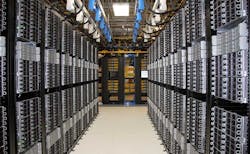The new LinkedIn data center in Hillsboro, Oregon breaks new ground in Internet-scale data centers, combining high density with exceptional efficiency and sustainability. The facility, housed in a new phase of the Infomart campus outside Portland, is the culmination of an 18-month journey in which LinkedIn has doubled its infrastructure and overhauled its design.
The new design includes one of the largest deployments yet of rear-door chilling units that support extreme power density. The facility also makes use of free cooling via water-side economization, and runs on 100 percent renewable power. It is connected by a new network fabric, known as Project Altair, designed to optimize latency.
To learn more about this unique facility, Data Center Frontier had a question-and-answer session with the team behind the data center:
- Mike Yamaguchi, LinkedIn’s Director of Data Center Engineering
- Shawn Zandi, LinkedIn Principal Network Architect
- John Sheputis, President of Informart Data Centers
- Julian Kudritzki, Chief Operating Office of the Uptime Institute, which awarded the LinkedIn project its Efficient IT Stamp of Approval.
Data Center Frontier: One of the most interesting elements of the LinkedIn Portland project is the cooling design. What led you to use this approach (rear-door chilling unit from MotivAir) and what were the pros and cons of this design?
Mike Yamaguchi (LinkedIn): There were two main factors that led us to deploy a rear door heat exchanger technology in our Oregon facility. First, we were challenged with supporting cabinet designs up to 24kW. Second, we wanted to achieve the highest level of efficiency. By transferring the heat generated by the high density compute nodes to water closer to the source, we are able to leverage the naturally cool ambient Oregon air nearly 220 days a year to reject that heat, as opposed to using energy to create cool water.
We collaborated with Infomart, DPR, and MotivAir to build customized automated logic to maximize the operating efficiencies of the doors by monitoring several input factors such as air pressure, water pressure, and water temperature. One major benefit was our ability to hit a PUE of 1.06, but operationally speaking, this design specifically allows us the flexibility to have a wide variety of cabinet densities, while maximizing our space, power, and cooling. The trade-off of course was adding an additional design element to every rack.
Here’s a closer look at the MotivAir rear-door chilling units installed in the “hot aisle” in the LinkedIn data center in Portland, Oregon. (Photo: LinkedIn)
Data Center Frontier: What prompted your choice of Portland and Infomart for this project?
Shawn Zandi (LinkedIn): Several key considerations led us in selecting Hillsboro and Infomart as the next location for our flagship data center. For the locale, we were/are able to leverage the Trans Pacific cable system to connect to our global backbone and leverage free cooling the majority of the year. As for Infomart, their building has direct access to renewable energy, expansion opportunities and a collaborative team that was as excited to work with us on our design as we were.
We worked toward a solution to maximize the rack power density against design capacity. Dense compute project, we were able to fit into higher power per sq/ft which translate into gain in efficiency
Data Center Frontier: The Project Altair facility supports density that is significantly higher than many other hyperscale data centers. What led you to this approach, and what are its benefits?
Mike Yamaguchi, LinkedIn: In addition to dense-compute, the move to pizza box (1 rack unit) building blocks instead of big chassis, also enabled us to save power and space in addition to maintaining baseline temperature.
One thing we were able to do is standardize on components that were not only more economical as being commoditized, but offered more overall throughput. Once we began to realize those efficiencies, we wanted to push the envelope as much as was prudent. This design is one we want to eventually replicate in our other data centers.
A row of servers inside the LinkedIn Portland data center. The Project Altair design supports densities of up to 24 kW per rack. (Photo: LinkedIn)
Shawn Zandi (LinkedIn): The other consideration is that for our private cloud architecture, LinkedIn Platform-as-a-Service (LPS), we wanted to create an low latency data center fabric that allows service instances in any part of the data center to communicate with each other seamlessly. This is in contrast to the higher latency architectures used by most public cloud providers as they are built as based on a multi-purpose and multi-tenant foundations.
Data Center Frontier: LinkedIn Portland is perhaps the most efficient space deployed by a multi-tenant provider on behalf of a client. What has been different about this project that created this level of efficiency?
John Sheputis (Infomart Data Centers): While the project PUE is excellent, the more innovative operational efficiencies are gained in how cooling and power resources are controlled and delivered. We can discuss this in terms of the external plant, cooling in the data hall, and conditioned power delivery.
The plant design started with fairly efficient cooling towers and chillers, and took advantage of Portland’s climate to leverage water side economization. While there are occasional hot days in Portland, summers tend to be drier and milder compared to most of the US, meaning the plant operates in ‘free cooling’ conditions the vast majority of the year.
An aerial view of the Infomart Data Centers campus in Hillsboro, oregon which houses the new LinkedIn facility. (Photo: LinkedIn)
The bigger breakthrough was inside the data hall. Every data center designer knows that containment (hot or cold aisle) improves efficiency. But rather than contain a row as we would in most cases, by using rear door heat exchangers, we drove containment to the rack level. This approach gave us an unprecedented level of control in managing the cooling resource to exactly where and when needed. The improved control allowed us to raise the delivered water temperature. With a cold air objective of 75 degrees, the chilled water supply can be as warm as 67 degrees. Producing warmer chilled water saves energy year round and expands the number of ‘free cooling’ days. There are additional benefits to warmer water, namely eliminating condensation risk. For any acceptable range of relative humidity, the pipes will be above the dew point. Less insulation on pipes lowers construction and maintenance costs as well. We plan to use warmer water in future projects, with or without rear door heat exchangers.
Last, our production and delivery of conditioned power is state of the art. We start with highly efficient UPS, and operate in the eco-mode, which saves power through less dual conversion. The conditioned power is then delivered to the floor at 415 volts, which lowers line loss. Power is delivered to 400A Starline bus above the racks, which allows more flexibility for rack densities and results in less stranded capacity. We plan to use higher delivery voltage in future projects as well.[clickToTweet tweet=”John Sheputis: This approach provided an unprecedented level of control in managing the cooling resources.” quote=”John Sheputis: This approach provided an unprecedented level of control in managing the cooling resources.”]
Data Center Frontier: The Uptime Institute has seen a lot of data center deployments. What are the aspects of LinkedIn Portland that stand out and differentiate it? Are these innovations specific to this project or do they have benefits from the broader industry?
Julian Kudritzki (Uptime Institute): LinkedIn Infomart-Portland is the poster child for Efficient IT by establishing core directives at the top that resonated through the organization and aligned a variety of expertise and staff levels. The goals of IT Optimization and Reduced Waste were emulated in the organizational structure itself—with a sustainability stakeholder embedded within the Data Center Engineering and IT Infrastructure group. At the rate of growth, and the immediacy of their business requirements, LinkedIn’s governance-level discipline is all the more impressive. While not every organization is at the scale of LinkedIn, the tenets of organizational commitment and comprehensive approach can be mirrored in enterprise IT organizations of any size.
For more information:
- LinkedIn Engineering Blog: Introducing LinkedIn’s West Coast Data Center by Michael Yamaguchi.
- Infomart Blog: Enabling the Most Efficient IT Operation in the World by John Sheputis
LinkedIn will discuss its Portland project this Tuesday at the Gartner Data Center, Infrastructure & Operations Management Conference in Las Vegas. The keynote presentation will feature Sonu Nayyar is the Vice President of Global Operations at LinkedIn.






